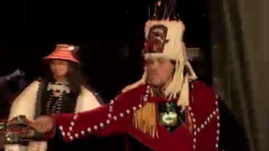Teachers' Domain - Digital Media for the Classroom and Professional Development
User: Preview



Three dancers of the Git-Hoan troupe perform the Chief’s Headdress Dance celebrating the meaning found in the leader’s ceremonial headwear. The Git-Hoan are descendants of the Tsimshian people of northwest Canada and Alaska.
This resource is part of the Native American Culture collection.
Find additional arts resources for your classroom at the KET Arts Toolkit website.
Git-Hoan are descendants of the Tsimshian people of northwest Canada and Alaska. Git-Hoan means “people of the salmon.” Like all Northwest peoples, the Tsimshian thrived on fishing, and salmon continues to be a staple of their diet today. The Tsimshian lived in large longhouses made from cedar house posts and panels. These were very large and often housed an entire extended family. The summer months were spent in the cultivation, hunting, and preservation of food to see the community through the difficult winters. Winter was a time of ceremony and reflection for the Tsimshian.
Like many peoples of the Northwest, the Tsimshian traditionally hold winter potlatches, which they call yaawk or feast. The main purpose of the potlatch is the redistribution and exchange of wealth through gifts such as dried foods, sugar, flour, or other materials and products. Even today, everyone who attends a potlatch is given a present. Wealth is measured by how much the host can give away. It serves ceremonial, social, and economic purposes. Along with feasting, there is singing and dancing, sometimes with masks or regalia.
There were long periods when potlatches were rigorously banned by both the United States and Canadian governments. As a result of this, combined with massive epidemics in the 19th century and the policies of missionaries, much of the traditional Tsimshian culture has been lost. The Chief’s Headdress Dance and song are among the few that have survived from the old traditions.
The chiefs of the Tsimshian did not wear the feathered war bonnets made famous by the Indians of the Plains. Instead they wore carved wooden plaques decorated with sea lion whiskers and fur. For this dance, the headdresses are filled with eagle down and the dancers spread the eagle down. David Boxley, leader and culture bearer of the Git-Hoan Dancers, explains that the Chief’s Headdress Dance was performed to begin a potlatch, the host dancing for the guests before the guests dance for the host. The spreading of the eagle down symbolizes the spread of peace and prosperity to everyone present.
 Loading Standards
Loading Standards